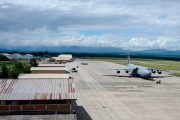
A study from the Rand Corporation shows that drug smugglers and their counterparts, the unscrupulous operators who are driving city-sized hordes of Central American illegals toward the southwest border of the United States, are making a fortune.
Rand’s Homeland Security Operational Analysis Center says the smugglers could be earning up to $2.3 billion annually, with drug traffickers in particular collecting “taxes” from the exploited, penniless hordes to proceed unmolested.
But the center admits that its estimates wildly fluctuate, which is not surprising given what its analysts tried to study: a network of criminals and how they much make from “clients” who are themselves breaking the law to get here.
Routes and Charges
As The New American has reported, citing U.S. border officials, 70 percent of the illegal-alien tsunami that hits the border each day — a figure that reached more than 4,600 during May — is from the Northern Triangle of Guatemala, Honduras, and El Salvador.
A map in the report, taken from Amnesty International, shows that they generally follow three routes into Mexico. Those three end in two, one of which heads up Mexico’s east coast. The other runs toward Mexico City and Guadalajara. From that area, the illegal-alien corridor branches into three: one heads north to Nuevo Laredo, a second runs to Ciudad Juarez, while a third travels up the country’s west coast to Nogales and Tijuana.
The smugglers, the report says, provide a number of services and play a number of roles. They “identify and recruit migrants, collect up-front fees, pay other smuggling organizations during the migrants’ journey, and coordinate some or all the migrants’ travel from their source country to their final destination.”
Of course, they also provide transportation that includes everything from “taxis to charter buses and tractor-trailers,” as well as logistical support, often in the form of lodging or ‘stash houses’ where migrants can take shelter for a few days or even a few weeks.”
In other words, the illegal-alien invasion of the United States is no spontaneous movement of Central America’s poor, huddled masses yearning to breathe free. It’s a coordinated, profit-making assault on American sovereignty.
The Money
The center’s revenue estimate varies widely, but it offers at least something of a picture of the money involved:
In 2017, the averages of the reported smuggling fees in the DHS data were about $4,700 per person for Guatemalan migrants, $3,800 per person for Honduran migrants, $4,600 per person for Salvadorian migrants, and about $4,400 per person for NT migrants overall…. The median figures for the same year were similar but predictably lower, given the density of low-end observations, the presence of high-end outliers, and considerable other “noise” in the data, with $4,000 for Guatemalan migrants, $3,000 for Honduran migrants, $4,000 for Salvadorian migrants, and $4,000 for NT migrants overall. These mean and median figures were less than expected, given recent press reports and conversations with [experts] that suggested fees ranging from $6,000 to $10,000 or more but, as noted above, could also reflect migrants’ preferences for particular or fewer services.
The center estimated total smuggling revenues to be at $200 million and as much as $2.3 billion.
Beyond those fees, migrants also pay taxes to the drug smugglers who control the routes, the center reported. The movement of the illegals requires close coordination of the drug and human smugglers. The center estimated that the drug traffickers collected between $30 million and $180 million in “taxes” from the illegals.
Those taxes might not be included in the initial smuggling fee the illegals pay, which means total revenues could reach nearly $2.5 billion.
Revenues Aren’t Going Down
And those revenues aren’t likely to go down anytime soon, given the number of illegals who crossed the border in May.
Figures from Customs and Border Protection are worsening by the month: 144,278 illegals hit the border in May, up from April’s 109,474. That’s a 31.7 percent increase.
In keeping with what CBP has reported in the past, the majority, 366,931 or nearly 55 percent, arrived in “family units,” a new tactic illegals and smugglers adopted because they know border officials will release them.
The number of illegals who crossed the border thus far in fiscal 2019 is 676,315.
Last week, Mexico promised a crackdown on the out-of-control human deluge after President Trump threatened to hit the nation with tariffs as high as 25 percent.
Photo: Nastasic/E+/Getty Images



